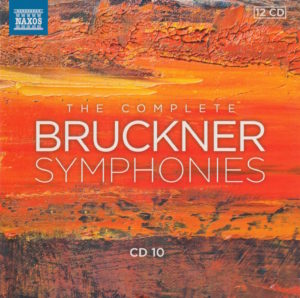
Only one day left in this leg of my journey!
This morning’s conductor of Anton Bruckner’s unfinished Symphony No. 9 in D Minor WAB 109 (dedicated “to the beloved God”) is Georg Tintner (1917-1999), the Austrian-born composer/conductor with whom I was already familiar prior to starting my 144-day exploration of Bruckner’s music.
Tinter’s orchestra is the Royal Scottish National Orchestra.
I first encountered Georg Tintner (in this project) on Day 15, Symphony No. 1.
Then again on Day 31, Symphony No. 2.
Then again on Day 47, Symphony No. 3.
Then again on Day 63, Symphony No. 4.
Then again on Day 79, Symphony No. 5.
Then again on Day 95, Symphony No. 6.
Then again on Day 111, Symphony No. 7.
Then again, most recently, on Day 127, Symphony No. 8.
First, the objective aspects of this recording:
 Bruckner’s Symphony No. 9 in D Minor WAB 109, composed 1887-1896
Bruckner’s Symphony No. 9 in D Minor WAB 109, composed 1887-1896
Georg Tintner conducts
Tinter used the version “ORIGINAL 1894 VERSION, ED. L. NOWAK,” according to the back of the CD sleeve
Royal Scottish National Orchestraplays
The symphony clocks in at 60:22
This was recorded at Henry Wood Hall, Glasgow, on 8th and 9th May 1997
Tintner was 80 when he conducted it
Bruckner was 72 when he died before finishing the Ninth
This recording was released on the Naxos label
Bruckner wrote his symphonies in four parts. He would have this time, too. But he died before completing movement four. The time breakdown of this one (Symphony No. 9 in D Minor), from this particular conductor (Tintner) and this particular orchestra (Royal Scottish National Orchestra) is as follows:
I. Feierlich, misterioso (D minor)…………………………………………………………………25:47
II. Scherzo. Bewegt, lebhaft (D minor); Trio. Schnell (F-sharp major)…………………………………………………………………………………………………………….9:58
II. Adagio. Langsam, feierlich (E major)……………………………………………………….24:14
IV. Finale. (D minor, incomplete)……………………………………………………………………0:00
Total running time: 60:02
There doesn’t seem to be an entry on the Wiki page for the “Original 1894 Version” of this symphony. However, the Wiki entry does single out the Nowak edition:
This is a corrected reprint of the Orel edition of 1932.
According to its entry on Wiki, the Orel edition,
Orel edition (1932)
This was the first edition that attempted to reproduce what Bruckner actually wrote. This version was first performed in 1932 by Siegmund von Hausegger with the Munich Philharmonic Orchestra. In the concert, the symphony was performed twice, first in Löwe’s edition and then in the Orel version. It includes only the first three complete movements.
So if this is based on the Nowak edition, then that probably means Georg Tintner used the Orel edition.
From the superb liner notes, written by Maestro Tintner himself,
Unfinished masterpieces sometimes assume a new life of their own. For instance Schubert, who let more unfinished works than anyone else, may have had his reasons for not completing his marvellous Quartettsatz, but now it stands by itself as a complete work…The already ailing Bruckner spent the last two years of his life trying frantically to complete the Finale of his Ninth Symphony. It is not mean cruelly when I say that I for one am glad that Fate did not grant him his wish, because the material intended for the Finale is just as unworthy of what is perhaps Bruckner’s greatest music, as is the unfinished material of Schubert’s Either Symphony.
Maestero Tintner calls the Adagio, “a heart-rending farewell to the world.”
Now the subjective stuff:
My Rating:
Recording quality: 4
Overall musicianship: 4
CD liner notes: 4 (lengthy essays, but incomplete recording/version information)
How does this make me feel: 5
I agree with Mr. Tintner. The Adagio truly is heart-rending. One of the finest pieces of music I’ve ever heard in my life.
This performance is back to the Tintner I’ve come to know and love.
It’s a fine interpretation of the Ninth, especially the Scherzo and the Adagio.
A worthy effort from all concerned.
Huzzah!
